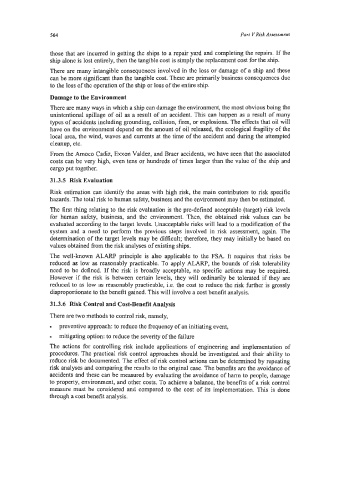Page 588 - Marine Structural Design
P. 588
564 Part V Risk Assessment
those that are incurred in getting the ships to a repair yard and completing the repairs. If the
ship alone is lost entirely, then the tangible cost is simply the replacement cost for the ship.
There are many intangible consequences involved in the loss or damage of a ship and these
can be more significant than the tangible cost. These are primarily business consequences due
to the loss of the operation of the ship or loss of the entire ship.
Damage to the Environment
There are many ways in which a ship can damage the environment, the most obvious being the
unintentional spillage of oil as a result of an accident. This can happen as a result of many
types of accidents including grounding, collision, fires, or explosions. The effects that oil will
have on the environment depend on the amount of oil released, the ecological fragility of the
local area, the wind, waves and currents at the time of the accident and during the attempted
cleanup, etc.
From the Amoco Cadiz, Exxon Valdez, and Braer accidents, we have seen that the associated
costs can be very high, even tens or hundreds of times larger than the value of the ship and
cargo put together.
31.3.5 Risk Evaluation
Risk estimation can identify the areas with high risk, the main contributors to risk specific
hazards. The total risk to human safety, business and the environment may then be estimated.
The first thing relating to the risk evaluation is the pre-defined acceptable (target) risk levels
for human safety, business, and the environment. Then, the obtained risk values can be
evaluated according to the target levels. Unacceptable risks will lead to a modification of the
system and a need to perform the previous steps involved in risk assessment, again. The
determination of the target levels may be difficult; therefore, they may initially be based on
values obtained fiom the risk analyses of existing ships.
The well-known ALARP principle is also applicable to the FSA. It requires that risks be
reduced as low as reasonably practicable. To apply ALARP, the bounds of risk tolerability
need to be defined. If the risk is broadly acceptable, no specific actions may be required.
However if the risk is between certain levels, they will ordinarily be tolerated if they are
reduced to as low as reasonably practicable, i.e. the cost to reduce the risk further is grossly
disproportionate to the benefit gained. This will involve a cost benefit analysis.
31.3.6 Risk Control and Cost-Benefit Analysis
There are two methods to control risk, namely,
preventive approach: to reduce the ffequency of an initiating event,
mitigating option: to reduce the severity of the failure
The actions for controlling risk include applications of engineering and implementation of
procedures. The practical risk control approaches should be investigated and their ability to
reduce risk be documented. The effect of risk control actions can be determined by repeating
risk analyses and comparing the results to the original case. The benefits are the avoidance of
accidents and these can be measured by evaluating the avoidance of harm to people, damage
to property, environment, and other costs. To achieve a balance, the benefits of a risk control
measure must be considered and compared to the cost of its implementation. This is done
through a cost benefit analysis.

